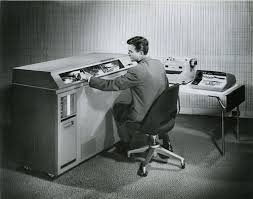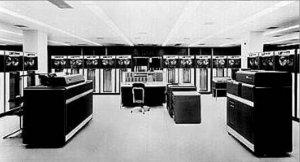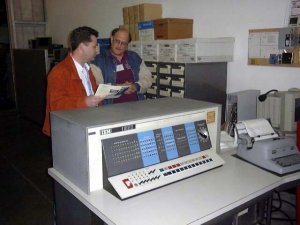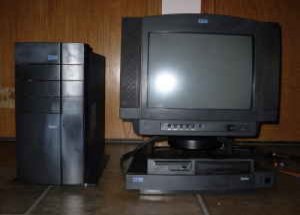Well, when I first started in computers no one had heard of monitors yet, you got your out put via IBM Electric Typewriters, or large bulky IBM drum printers. The unit I started on was the IBM 610, a bulky and primitive machine. it had a large box like a refrigerator turned on it side which contained a paper tape reader and paper tape punch, magnetic memory drum, and other circuit boards. A small desk had an IBM electric typewriter (for entering the program code) and a console with a lot of "sense" switches to tell the machine how to operate. We had an oscilloscope (about 3.5" in diameter) which you could by straining your eyeballs read what was in a memory location. It had 84 memory locations of 31 digits each (quite a high precision). In the morning you had to turn it on and wait 20 minutes for the memory drum to spin up to speed and stabilize so you could use it. You typed your program in via the typewriter and punched on the oily paper tape which would then advance to the read head. Then you backed up the paper tape until it was at the read head, flipped a switch on the console to run and checked out your results. If your program was working correctly you once again backed up the tape to be ready for the read head and threw another switch which would have the punch head duplicate what the read head was doing -- you normally had to do this to make a second run of the program without manually having to type in the instructions again or to keep backing up the tape. This would let the machine run "automatically" until you got the needed results. Particularly handy when using iteration type programs -- in the main one I did tracking rockets down range and predicting where they would be at certain times. All program operations would put the answer in an "accumulator" location in memory; and, you then had to save the accumulator memory to somewhere else as the next operation would wipe it out. You were constantly shiftitng things around to save them or printing them out on the typewriter (which would handle 17" wide green and white computer type output paper via tractor feed via the holes punched on either side of the paper). Rental of this high powered machine was around 1,150 a month or 55 thousand for outright purchase.

More another time, have fun modeling, Swamp Daddy

More another time, have fun modeling, Swamp Daddy
Last edited:





